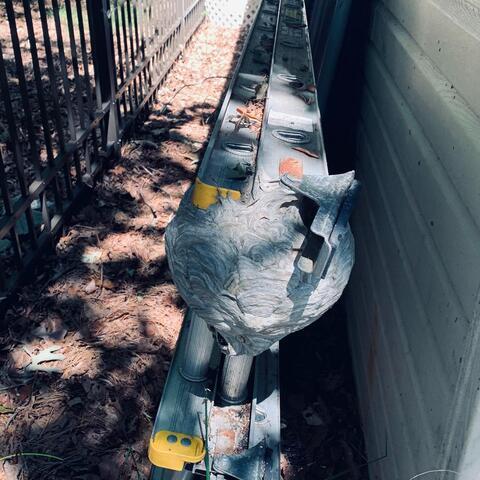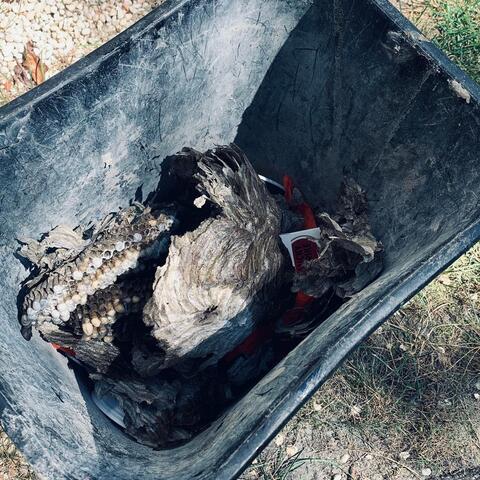Pests We Treat Before & After Photos
Click on a photo to enlarge.
Bald-Faced Hornets Use the Ladder in West Windsor, NJ
Recently, we were sent out to a home in West Windsor, NJ to treat for hornets. We were informed that the nest was located on the bottom of the customers ladder, so that's where we inspected. As we took a closer look at them, we identified them as bald-faced hornets. Bald-faced hornets are social stinging insects that have white markings on their face. They're EXTREMELY aggressive and territorial. So aggressive that if anyone or anything comes within close proximity of their nest, they will attack! What makes them even scarier is they can actually sense vibrations in the air (when you mow your lawn) and remember their invader's face!
First, we injected a knockdown dusting application into the nest, waited a few moments, and then injected a knockdown aerosol application. Both of these applications quickly exterminate the bald-faced hornets. Several moments after applying these products, we removed the nest and disposed of it properly.
Chocolate Stolen by Mice in Plainsboro, NJ
A new customer in Plainsboro, NJ called Cowleys after hearing some scratching and "other odd noises" in her kitchen, so we were sent out to investigate. As we inspected the kitchen, we noticed some rodent droppings near the stove. So we asked the homeowner to move it. As soon as she did, we found a massive buildup of mice droppings and candy wrappers behind the stove.
Apparently the mice were stealing the candy from the bowl on top of the counter and bringing it behind the stove! There was also an opening around the gas pipe that lead outside, which also had a wide opening around it. This was how the mice were able to get into the home! First thing we did was carefully vacuum up all the mice droppings behind the stove. After that, we installed several rodent bait stations throughout the kitchen, behind the stove, and in several locations around the exterior of the home.
The last thing we did was schedule a number of return visits to monitor the infestation and replenish the bait stations as needed. On our next visit, we're going to properly close off all the openings inside and outside of the property that the mice are using to infest the home.
Beginnings of a Paper Wasp Nest Found in the Attic in Martinsville, NJ
During a startup treatment service for a new Home Protection Plan customer in Martinsville, NJ, we found a small but active paper wasps nest attached to the gable vent in the attic. Paper wasps are semi-social stinging insects that usually have brown bodies with yellow or reddish markings and received their name from the paper-like material out of which they make their nests. A sting from a paper wasp can be extremely painful and can cause allergic reactions in some people.
As we took a closer look, we noticed that there was a hole in the gable vent. Over time the gable vents get weathered and pests, as well as nuisance wildlife, take advantage of these openings and infest homes. For treatment, we grabbed our extendable pole, attached an aerosol product to it, and injected it into the nest. This treatment rapidly neutralizes the paper wasps. Moments later, we removed the nest, disposed of it, and applied a residual application to the area to prevent the paper wasps from returning and rebuilding their nest.
Although we offered to replace the gable vent for the homeowner, she mentioned that she will install it on her own at a later date.
Paper Wasps Hanging Out by the Back Door in Monmouth Junction, NJ
As this elderly homeowner in Monmouth Junction, NJ, was sitting on her back porch, enjoying the beautiful weather, she spotted a wasp nest in the corner of her home. Since she is highly allergic to wasps and is a current Home Protection Plan customer, she immediately called our office for help. When we arrived and took a closer look at these stinging insects, we identified them as paper wasps.
Paper wasps, also called umbrella wasps, are semi-social stinging insects that usually have brown bodies with yellow or reddish markings. They range in size from five-eighths to three-quarters of an inch long and are known for the long legs that extend out from their oval bodies. Due to their coloration and body shape, they are often mistaken for yellow jackets but have a slimmer waist and a triangular side view. Paper wasps received their name from the paper-like material out of which they make their nests. A sting from a paper wasp can be extremely painful and can cause allergic reactions in some people.
We treated the nest with a knockdown liquid application, which will exterminate them almost immediately. After several moments, we removed the nest and treated the area with a liquid residual. This application will eliminate any returning paper wasps as well as prevent them, and any other stinging insect, from building a nest.
Gap on the Side of Garage Door Allows Rats Into the Home in Hightstown, NJ
We've returned to this home in Hightstown, NJ to check up on the rat activity as well as replenish all of our rodent bait stations throughout the property. After refilling all of the bait stations, we're going to seal up the main access point for the rats - which was a wide opening on the side of the garage.
First, we stuffed the opening with chew-proof copper mesh, which rats hate the taste and feel of. Next, we sealed it in place with a premium, waterproof adhesive. We're going to repeat this process to any and every single gap and opening around the home to prevent all rodents from invading the home.









